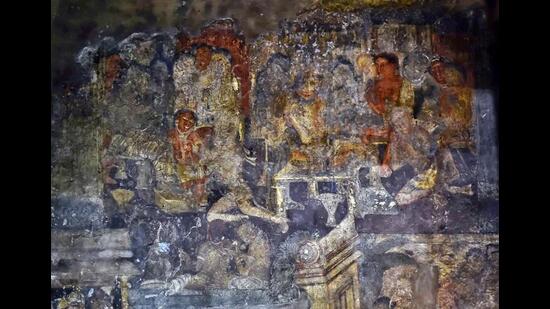Prakrit poetry for posterity
The Gatha Saptashati, an anthology of 700 poems on everything from nature and love to the general experiences of ordinary people, still enthrals
Ancient history tells us that the Satavahanas ruled over large parts of the Deccan, including (at various times) western Maharashtra, Andhra, and even parts of central India like Madhya Pradesh. They controlled a number of lucrative ports, which contributed to their wealth, as we know from the accounts of Greek and Roman merchants who traded with them. They were continuously engaged in skirmishes with foreign invaders, like the Sakas, and with other rival dynasties. In spite of ongoing military conflict, the Satavahanas appear to have found time to sponsor Ajanta cave art, donate generously (to various religions – they patronized both Brahmin villages and Buddhist monasteries), and maintain scholars at court, while some even became poets themselves.


The most famous poet among the Satavahana kings was Hala. Ruling at a time when the Satavahanas were in a particularly violent conflict with the Sakas, he had a very short reign of only four years (20-24 CE). Despite his short life, Hala ensured that he made a lasting mark on posterity, by composing the Gatha Saptashati. This was an anthology of 700 poems written in Prakrit, of which more than a hundred were composed by the king himself. Legend has it that Hala announced a huge poetry contest with massive prizes for the four best poems. This attracted a large number of submissions from the common people of the kingdom. So many of them were of high quality, that Hala ended up including them in his anthology. The poems largely deal with the experiences of ordinary people; there are poems on nature, on love, and on various hardships. I include a few poems from the Gatha Saptashati below; each original verse is followed by my translations.
Ushnani nihshvasan kila shayanardhe kimiti mama parangmukhyah
Manasamapyanushayataha pradeepya prishtham pradeepyasi.
(Gatha Saptashati verse 33).
I turn away, tucked in my half of our bed.I don’t know why you’re sighing so hotly –Having already inflamed my brainWith fury, are you now tryingTo see if you can burn my back, too?
Avatarati pashya nabhaso marakatamanipadmaragasamvalita
Gaganashrigalamadhyat galita kila kanthikeva shukapanktih.
(Gatha Saptashati verse 74).
Emerald green against ruby red,The flock of parrots descends from the evening skyA jeweled green necklace slippingFrom Dusk’s lovely throat.
Vajrapatanatiriktam patyuh shrutva tu shinjineeghosham
Svasadrishabandeenamapi bandya drak pronchite nayane.
(Gatha Saptashati verse 54).
The captive woman quickly wipes away the tearsOf her fellow prisoners. Help is at hand, she thinks –She’s mistaken a loud thunderclapFor the twanging of her husband’s bowstring.

Aganitasamastayuvaka bala vyutkrantalokamaryada
Atha sa bhramati dishamukhavikasitakshee tava kritena.
(Gatha Saptashati verse 56).
Hey boy! It’s your doing that she Doesn’t have eyes for any other young men,She’s dispensed with social proprieties,And now wanders about, all her senses alertFor news of you!
Shakyo vodhum yavanstavantam dehi me pranaya
Sarvo jano nivrittaprasadapeedasaho na ayam.
(Gatha Saptashati verse 81).
Give me your love for just as longAs you feel it’s light and easy to handle:I’m not like others, who can’t bear the painOf a lover’s withdrawal of interest.
Drishtena tena matuli tatkshanamavatrishnaveekshaneeyena
Trishnaiva napayata payaseva svapnapeetena.
(Gatha Saptashati verse 93).
Aunt, I’ve been thirstingFor that man – that cynosure of all eyes –From the moment he looked at me.His gaze couldn’t quench my thirstJust as if I’d drunk water – but only in a dream.
Much later, sometime around 800 CE, king Hala himself became the subject of a romantic epic poem – the Lilavati. The poem describes his romance with a princess from Ceylon, and dramatically narrates the obstacles he had to deal with before he could marry her.
READ MORE: Chronicles in the language of ghosts, birds and beasts
As I detailed in an earlier article , at least one Satavahana king also featured as a character in the Brihatkatha, a now lost Paishachi language manuscript dated by scholars to the first century BCE. While the Ramayana and the Mahabharata were the largest sources of literary inspiration for subsequent Indian literature, both in Sanskrit and in the vernacular languages, the Brihatkatha was also a source of story material that inspired countless plays, novels, and works of poetry. In particular, one of the later Sanskrit versions of Brihatkatha – the Katha-sarit-sagara or “The Ocean of Streams of Story” became particularly famous. As for the Gatha Saptashati, the charming quality of the poems continues to capture the interest of present-day readers, showing that emotions are universal across time and space.

The Satavahana rulers’ ventures in other fields were also pervaded by a literary and scholastic flavour. This is evident in some famous inscriptions engraved by Satavahana queens. The second-century CE Nashik inscription by queen mother Gautami Balashri praises her son, king Gautamiputra Satakarni. It records his dominions, his military conquest of the Sakas and his seizing of their entire treasury, and his donations, but also poetically praises his beauty, saying that his “face was beautiful and pure like the lotus opened by the rays of the sun.” An even earlier inscription, dated to the first century BCE, was by queen Nayanika, a Satavahana queen who ruled the kingdom as regent for her young son after the death of her husband, Satakarni I, and was engraved in Naneghat, a pass in the Western Ghats. The Naneghat inscription factually records a number of donations made by the queen, but goes into so much detail that after its discovery by modern scholars, it became an important part of the study of the history of number systems!
This literary activity becomes even more impressive when we consider that it took place on a backdrop of continuous military feud and conflicts. Although the Satavahana dynasty disappeared after the third century CE, but their mark on learning and literature still endures.
Brishti Guha has a PhD in economics from Princeton and is currently an associate professor at the School of International Studies, JNU.
All Access.
One Subscription.
Get 360° coverage—from daily headlines
to 100 year archives.



HT App & Website






